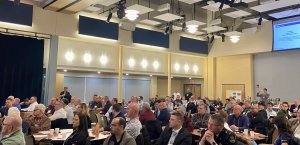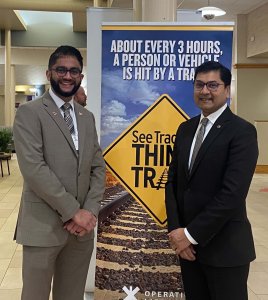
Nearly 200 attendees from rail organizations across the nation came to Rutgers for the FRA’s trespassing prevention workshop.
Nearly 200 transportation leaders from agencies across the nation visited the Rutgers School of Engineering to discuss how the rail industry can improve public safety along its thousands of track miles.
Every three hours a person or vehicle is hit by a train in the United States — a pressing safety concern that was the focal point of the Federal Railroad Administration’s (FRA) trespassing prevention workshop at Rutgers University earlier this month.
The extensive United States railroad system covers nearly 150,000 track miles with more than 200,000 highway-rail grade crossings, the intersections where highways and railroad tracks meet. Over the past decade, 96 percent of all rail-related fatalities have occurred at these crossings due to trespassing, suicide, and other accidents.
From January 30 through February 1, 2024, the FRA’s “Grade Crossing Safety and Railroad Trespass Prevention Workshop” brought together experts to discuss this very issue with the goal of identifying existing and emerging technology and approaches to mitigate, reduce, and eliminate highway-rail grade crossing and trespasser incidents.
The event was supported by the Rutgers University School of Engineering’s Center for Advanced Infrastructure and Transportation (CAIT).
“You have three days to step away from your hectic routine and this is your time to be innovative. To think, to learn, and to collaborate. If it feels like a luxury, embrace it,” said Parth Oza, assistant commissioner at the New Jersey Department of Transportation (NJDOT) and a Rutgers School of Engineering graduate.

FRA Administrator Amit Bose (right) and NJDOT Asst. Commissioner Parth Oza (left) provided opening remarks.
In his opening remarks, Oza described innovative approaches that NJDOT is taking at its rail-grade crossings in New Jersey, including deploying cameras using Artificial Intelligence with Rutgers engineers to document trespassing behavior and inform risk reduction strategies.
“Ideas such as this are born out of conferences just like this one,” he said. “So, when it comes to new ideas about safety, our railroad unit always has its gates up.”
The workshop began with sober statistics driving home the need for safety countermeasures.
From 2018 to 2022, grade-crossing fatalities rose nearly six percent nationwide with 272 people killed in 2022. Railroad trespassing fatalities rose by 22 percent over the same period, with 611 trespassing deaths reported in 2022.
Throughout the three-day event, speakers shared what safety measures are being implemented at their organizations, from installing “traffic channelization” barriers that physically prevent vehicles from crossing over a lane to go around grade-crossing gates, to utilizing anti-trespass panels near tracks and enhancing warning signs with LED lights.
Educational approaches such as hosting community awareness events and social media marketing were discussed. Resources were shared with the audience including the FRA’s Trespass and Suicide Prevention Toolkit, and results from the Volpe Center’s pilot program on law enforcement strategies for reducing rail trespassing.
FRA Administrator Amit Bose highlighted the importance of collaboration between different institutions in tackling this safety challenge.
“We, all of us here, have to commit to decreasing the number collisions, injuries, and fatalities that occur at highway rail crossings and along rail rights-of-way,” he said. “Whether it’s at the Federal Railroad Administration or our partners at the Federal Highway Administration, railroads, state and local departments of transportation, law enforcement, and other organizations.”
Asim Zaman, a Rutgers CAIT project engineer, helped organize the event and presented some of his work deploying innovative technologies at rail-grade crossings.
Funded by FRA and Federal Transit Administration (FTA) grants, Zaman and Rutgers researchers developed an AI-aided tool that automatically detects railroad trespassing events, differentiates types of violators, and generates video clips of infractions. The technology is being tested at locations across New Jersey, Florida, Pennsylvania, Connecticut, Massachusetts, and Louisiana.
“You manage what you measure, and artificial intelligence technology can measure safety like never before,” Zaman said. “AI can be used to measure before and after grade crossing safety improvements to determine what’s working, and how we can improve further.”
Until now, most railroad trespassing data could not easily account for near-miss incidents that can provide valuable insight into trespassing behaviors. This AI tool provides railroad decision makers with more accurate data and actionable information for designing effective trespassing control and safety countermeasures.

Traffic channelization installation at a rail-grade crossing. Photo ©NCDOT/FRA.
“Grade crossing safety and trespassing prevention are top safety priorities for the rail industry. Rutgers holds a premier position in contributing to this line of research, thanks to our extensive collaboration with the FRA, FTA, state DOTs, and various industry partners,” said Xiang Liu, an associate professor in the Department of Civil and Environmental Engineering and director of the Rutgers Rail and Transit Program.
The workshop concluded with a session on different funding solutions that rail agencies can use to implement life-saving solutions at highway-rail grade crossings, from infrastructure changes to technology deployments and educational campaigns.
“My team, my staff, one of the main things that we talk about every day is ‘we’re just trying to save one life. If I can save one life, we’re going to make a difference,’” said James Payne, staff director of FRA’s Highway-Rail Grade Crossing and Trespasser Programs Division. “Because I am a firm believer in you never know how that one life is going to affect somebody else. That individual that you saved may be the spiderweb that grows into saving other lives.”

